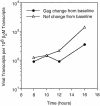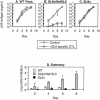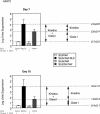Impacts of epitope expression kinetics and class I downregulation on the antiviral activity of human immunodeficiency virus type 1-specific cytotoxic T lymphocytes
- PMID: 14694087
- PMCID: PMC368806
- DOI: 10.1128/jvi.78.2.561-567.2004
Impacts of epitope expression kinetics and class I downregulation on the antiviral activity of human immunodeficiency virus type 1-specific cytotoxic T lymphocytes
Abstract
The determinants of CD8(+) cytotoxic T-lymphocyte (CTL) antiviral activity against human immunodeficiency virus type 1 (HIV-1) remain poorly defined. Although recent technological advances have markedly enhanced the ability to detect HIV-1-specific T cells, commonly used assays do not reveal their direct interaction with virus. We investigated two determinants of CTL antiviral efficiency by manipulating HIV-1 and measuring the effects on CTL suppression of viral replication in acutely infected cells. Translocation of a Gag epitope into the early protein Nef markedly increased the activity of CTL recognizing that epitope, in comparison to HIV-1 expressing the epitope normally in the late protein Gag. Because this epitope translocation resulted not only in earlier expression but also in loss of major histocompatibility complex class I downregulation by Nef, the activities of CTL against a panel of viral constructs differing in kinetics of epitope expression and class I downmodulation were compared. The results indicated that both the timing of epitope expression and the reduction of class I have profound effects on the ability of CTL to suppress HIV-1 replication in acutely infected cells. The epitope targeting of CTL and viral control of class I therefore likely play important roles in the ability of CTL to exert pressure on HIV-1.
Figures






References
-
- Ali, A., B. D. Jamieson, and O. O. Yang. 2003. Half-genome human immunodeficiency virus type 1 constructs for rapid production of reporter viruses. J. Virol. Methods 110:137-142. - PubMed
-
- Allen, T. M., D. H. O'Connor, P. Jing, J. L. Dzuris, B. R. Mothe, T. U. Vogel, E. Dunphy, M. E. Liebl, C. Emerson, N. Wilson, K. J. Kunstman, X. Wang, D. B. Allison, A. L. Hughes, R. C. Desrosiers, J. D. Altman, S. M. Wolinsky, A. Sette, and D. I. Watkins. 2000. Tat-specific cytotoxic T lymphocytes select for SIV escape variants during resolution of primary viraemia. Nature 407:386-390. - PubMed
-
- Baalen, C. A., C. Guillon, M. van Baalen, E. J. Verschuren, P. H. Boers, A. D. Osterhaus, and R. A. Gruters. 2002. Impact of antigen expression kinetics on the effectiveness of HIV-specific cytotoxic T lymphocytes. Eur. J. Immunol. 32:2644-2652. - PubMed
-
- Borrow, P., H. Lewicki, X. Wei, M. S. Horwitz, N. Peffer, H. Meyers, J. A. Nelson, J. E. Gairin, B. H. Hahn, M. B. Oldstone, and G. M. Shaw. 1997. Antiviral pressure exerted by HIV-1-specific cytotoxic T lymphocytes (CTLs) during primary infection demonstrated by rapid selection of CTL escape virus. Nat. Med. 3:205-211. - PubMed
-
- Brander, C., and P. J. R. Goulder. 2000. The evolving field of HIV CTL epitope mapping: New approaches to the identification of novel epitopes, p. I1-19. In B. T. M. Korber, C. Brander, B. F. Haynes, R. Koup, C. Kuiken, J. P. Moore, B. D. Walker, and D. Watkins (ed.), HIV molecular immunology database, vol. 2000. Los Alamos National Laboratory: Theoretical Biology and Biophysics, Los Alamos, N.Mex.
Publication types
MeSH terms
Substances
Grants and funding
LinkOut - more resources
Full Text Sources
Research Materials

